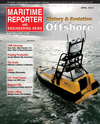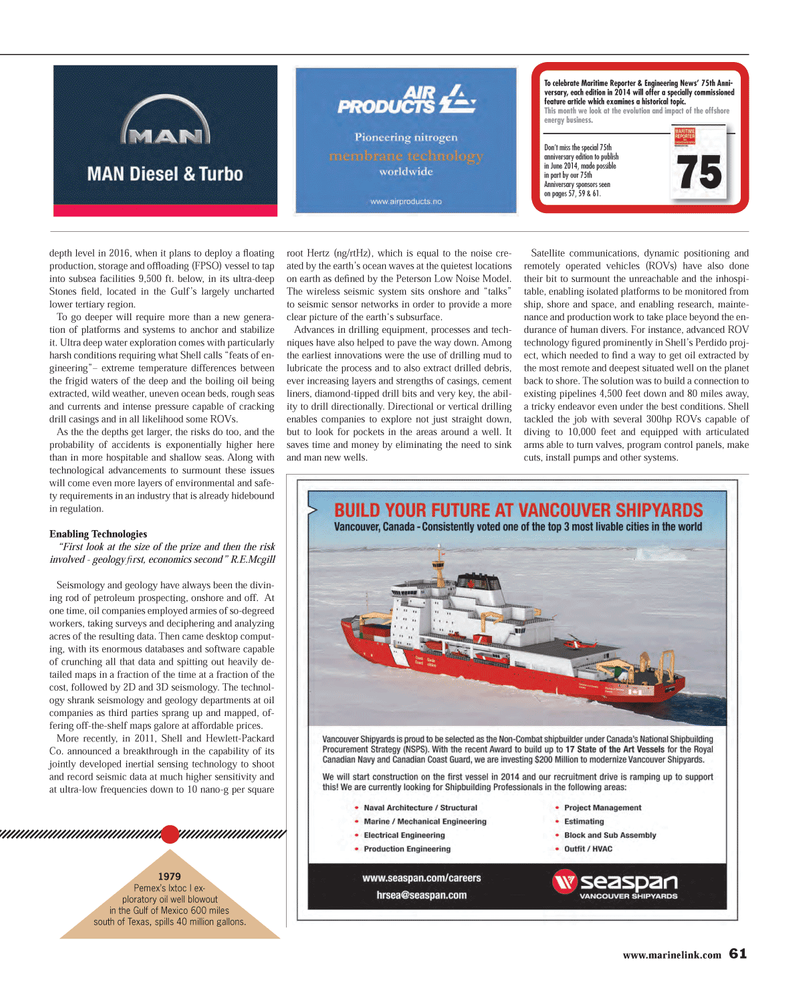
Page 61: of Maritime Reporter Magazine (April 2014)
Offshore Edition
Read this page in Pdf, Flash or Html5 edition of April 2014 Maritime Reporter Magazine
www.marinelink.com 61depth level in 2016, when it plans to deploy a ß oating production, storage and ofß oading (FPSO) vessel to tap into subsea facilities 9,500 ft. below, in its ultra-deep Stones Þ eld, located in the Gulf?s largely uncharted lower tertiary region.To go deeper will require more than a new genera- tion of platforms and systems to anchor and stabilize it. Ultra deep water exploration comes with particularly harsh conditions requiring what Shell calls ?feats of en-gineering?? extreme temperature differences between the frigid waters of the deep and the boiling oil being extracted, wild weather, uneven ocean beds, rough seas and currents and intense pressure capable of cracking drill casings and in all likelihood some ROVs. As the the depths get larger, the risks do too, and the probability of accidents is exponentially higher here than in more hospitable and shallow seas. Along with technological advancements to surmount these issues will come even more layers of environmental and safe-ty requirements in an industry that is already hidebound in regulation.Enabling Technologies ?First look at the size of the prize and then the risk involved - geology Þ rst, economics second? R.E.Mcgill Seismology and geology have always been the divin-ing rod of petroleum prospecting, onshore and off. At one time, oil companies employed armies of so-degreed workers, taking surveys and deciphering and analyzing acres of the resulting data. Then came desktop comput- ing, with its enormous databases and software capable of crunching all that data and spitting out heavily de-tailed maps in a fraction of the time at a fraction of the cost, followed by 2D and 3D seismology. The technol- ogy shrank seismology and geology departments at oil companies as third parties sprang up and mapped, of-fering off-the-shelf maps galore at affordable prices. More recently, in 2011, Shell and Hewlett-Packard Co. announced a breakthrough in the capability of its jointly developed inertial sensing technology to shoot and record seismic data at much higher sensitivity and at ultra-low frequencies down to 10 nano-g per square root Hertz (ng/rtHz), which is equal to the noise cre-ated by the earth?s ocean waves at the quietest locations on earth as deÞ ned by the Peterson Low Noise Model. The wireless seismic system sits onshore and ?talks? to seismic sensor networks in order to provide a more clear picture of the earth?s subsurface.Advances in drilling equipment, processes and tech-niques have also helped to pave the way down. Among the earliest innovations were the use of drilling mud to lubricate the process and to also extract drilled debris, ever increasing layers and strengths of casings, cement liners, diamond-tipped drill bits and very key, the abil- ity to drill directionally. Directional or vertical drilling enables companies to explore not just straight down, but to look for pockets in the areas around a well. It saves time and money by eliminating the need to sink and man new wells. Satellite communications, dynamic positioning and remotely operated vehicles (ROVs) have also done their bit to surmount the unreachable and the inhospi-table, enabling isolated platforms to be monitored from ship, shore and space, and enabling research, mainte-nance and production work to take place beyond the en-durance of human divers. For instance, advanced ROV technology Þ gured prominently in Shell?s Perdido proj- ect, which needed to Þ nd a way to get oil extracted by the most remote and deepest situated well on the planet back to shore. The solution was to build a connection to existing pipelines 4,500 feet down and 80 miles away, a tricky endeavor even under the best conditions. Shell tackled the job with several 300hp ROVs capable of diving to 10,000 feet and equipped with articulated arms able to turn valves, program control panels, make cuts, install pumps and other systems. 1979Pemex?s Ixtoc I ex- ploratory oil well blowout in the Gulf of Mexico 600 miles south of Texas, spills 40 million gallons. To celebrate Maritime Reporter & Engineering News? 75th Anni- versary, each edition in 2014 will offer a specially commissioned feature article which examines a historical topic. This month we look at the evolution and impact of the offshore energy business.Don?t miss the special 75th anniversary edition to publishin June 2014, made possiblein part by our 75th Anniversary sponsors seen on pages 57, 59 & 61.MR #4 (56-65).indd 61MR #4 (56-65).indd 614/7/2014 3:15:54 PM4/7/2014 3:15:54 PM

 60
60

 62
62
